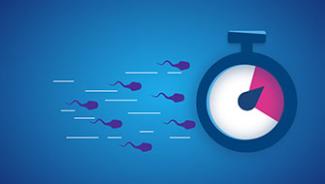When am I likely to ovulate?
To help you understand how ovulation works...
Over 99% accurate at detecting the LH surge
 To accurately identify your fertile days use an ovulation test that detects the changes in your personal fertility hormones in urine. Ovulation tests are 2x more accurate than calendar method3. Clearblue Digital Ovulation Tests are over 99% accurate in detecting the LH surge to identify your most fertile days.
To accurately identify your fertile days use an ovulation test that detects the changes in your personal fertility hormones in urine. Ovulation tests are 2x more accurate than calendar method3. Clearblue Digital Ovulation Tests are over 99% accurate in detecting the LH surge to identify your most fertile days.
(X) MYTH: Menstrual cycles are always 28 days long and every woman ovulates on day 14.
(✓)FACT: The average menstrual cycle is 28 days long, but every woman is unique and nearly 50% of women’s cycles vary by 7 days or more1. As menstrual cycles vary in length, so does the timing of ovulation, so it can be difficult to know when YOUR fertile days are.
Understanding your ovulation calculator results
There are many ovulation calculators available today that estimate when your fertile days will occur. These calculators are a form of ‘calendar method’ and work on average data without reading anything about your personal hormone levels. However, none of us are ‘average’:
1. Cycle lengths vary from woman to woman and cycle to cycle - in fact nearly 50% of menstrual cycles vary by 7 or more days1
2. The timing of ovulation can vary by a few days, even in regular cycles.
Should we have intercourse every day I am fertile?
Professor Bill Ledger
Sperm that are stored within the testicles for too long accumulate damage to the DNA and are less fertile. With couples who have frequent (daily) intercourse, the man will have a lower sperm count per ejaculation but the sperm will be more fertile. If you are trying to conceive then try to have intercourse at least every other day around the time of ovulation.
What is the difference between ‘ovulation’ and ‘fertile days’?
'Ovulation' is the process of an egg being released from an ovary and this happens 12-16 days before her next period starts.
'Fertile days' are the days during a woman's menstrual cycle, leading up to and including the day of ovulation, when she has the ability to become pregnant if she has unprotected sex.
When are the highest and lowest chances of getting pregnant?
The most fertile days each cycle when you have the best chance of getting pregnant from unprotected sex, are the day of ovulation and the day before – these are the 2 days of ‘peak fertility’. However, due to the fact that sperm can survive for several days in a woman's body during her fertile time there are also a few days before this when you also have an opportunity to get pregnant – these are the days of ‘high fertility’. Outside this ‘fertility window’ of about 6 days, the chances of getting pregnant are low.
Which method is more accurate?
Clearblue Digital Ovulation Tests are over 99% accurate in detecting the LH surge that happens 24-36 hours before ovulation, so they are more accurate than calendar and temperature methods at predicting the most fertile days2.
1. Creinin MD., et al. Contraception (2004) 70: 289-92
2. Brezina PR., et al. Fertil & Steril (2011); 95(6): 1867-78
3. Study of 101 women in the UK comparing a simple calendar method to likelihood of conducting a test on LH surge day (2011).
4. In a study of 87 women, 4 or more fertile days were identified in 80% of cycles using actual cycle length.

How to get pregnant faster?
Having sex at the right time of your cycle is key, so identifying your fertile days with an ovulation test will help you get pregnant faster.


